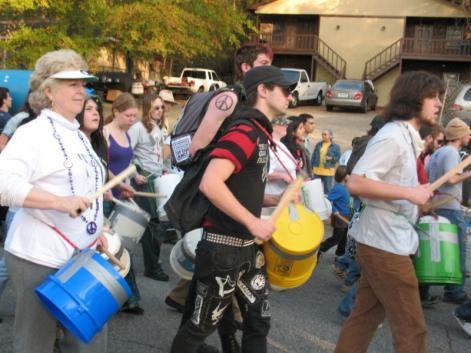Whether or not it includes a clear commitment to nonviolence, most of the basic steps in campaigns are the same: research and collect information, educate and train, develop a strategy. What, then, is unique about a 'nonviolent campaign'? It's certainly more than simply not being violent. Many organisations and campaigns committed to nonviolence have statements of their nonviolent principles that explain their perspectives. WRI's Statement of Principles describes what we mean when we say we embrace nonviolence:
Nonviolence can combine active resistance, including civil disobedience, with dialogue; it can combine non-cooperation—withdrawal of support from a system of oppression—with constructive work to build alternatives. As a way of engaging in conflict, sometimes nonviolence attempts to bring reconciliation with it: strengthening the social fabric, empowering those at the bottom of society, and including people from different sides in seeking a solution. Even when such aims cannot immediately be achieved, our nonviolence holds us firm in our determination not to destroy other people. (http://wri-irg.org/statemnt/stprinc-en.htm)
The following list identifies specific principles particular to nonviolence. While some of these may be found in campaigns that do not identify as being nonviolent, the combination of these principles makes a campaign nonviolent.
Principles of Nonviolent Action
These Principles were developed through a collaborative process, involving nonviolence trainers in the United States and the editorial committee of this Handbook. We encourage you to use this, or another set of principles, to stimulate discussion within your group. Use the 'Spectrum or Barometer' Exercise to help your group understand where members stand in relation to nonviolence principles. If there are large differences, you will need to discuss how that will affect your nonviolent campaign. The use of Nonviolent Guidelines may be the best way to define your agreements as a group (at least for the purposes of your campaign).
- We acknowledge the value of each person. This is fundamental: recognising the dignity and humanity of oneself and others. We refuse to mistreat our opponent as an enemy.
- We recognise that we all have part of the truth; no one has all of it. No one is all 'right or all 'wrong'. Our campaign information gathering, educations, and actions should reflect this.
- Our actions emphasise openness to promote communication and democratic processes. We work for processes that express 'power with' not 'power over' others. Empowering all involved in a campaign is important. We promote democratic structures (internally and externally) to maximise self-determination.
- Our means (behaviours and actions) are consistent with our ends (of affirming life, opposing oppression and seeking justice, valuing every person). Our strategy must be based on this principle, we cannot justify a 'victory' obtained through violent or deceitful methods.
- We are willing to undergo suffering rather than inflict it. Refusing to inflict suffering is based on the value of each person and is a strategy that draws attention to our commitment and our cause. We will not violently fight back if attacked. We recognise jail may be a consequence of our actions; filling the jails may be a strategy.
- We commit to prepare ourselves for nonviolent action according to the guidelines agreed. If necessary, we will attempt to arrange orientation sessions or workshops in nonviolence to better understand and practice this commitment.
Find Martin Luther King, Jr's principles of nonviolence at: http://www.thekingcenter.org/prog/non/6principles.html
Nonviolence Guidelines
Going back to the Code of Discipline laid down by Gandhi in the 1930's, many campaigns have developed 'nonviolence guidelines' to which all participants are asked to agree. 'Nonviolence guidelines' are not the same as nonviolent principles. They are agreements on how participants in an action will behave. They may be stated in very practical terms ('We will not carry any weapons') or may be in more philosophical terms ('We will gather together in a manner that reflects the world we choose to create'). Agreeing on what we mean by 'nonviolence' or why we choose nonviolence should not be assumed. Even in a small and apparently homogeneous group, discussion will bring up different interpretations and varied levels of commitment to nonviolence. Nonviolence guidelines make clear what is expected and set a nonviolent spirit for the action. In the midst of an action, it is easy for a crowd's tone to move in the direction of verbal abuse and even violence. Government infiltrators may attempt to discredit a group by urging people to act violently. Nonviolent agreements, and nonviolence training, can make it possible for a large number of people to participate in a campaign nonviolently, even if they have little experience in this area. No matter how committed the organisers are to the principles of nonviolent action and how well the campaign strategy is organised, it is crucial that the participants in demonstrations and civil disobedience actions to reflect the principles of nonviolence for it to be an effective nonviolent campaign.
Examples of nonviolence guidelines:
- Faslane 365: http://www.faslane365.org/fr/display_preview/nonviolence_guidelines
- Lakenheath Action Group: http://www.motherearth.org/lakenheathaction/nv.php3
- School of the Americas Watch: http://www.soaw.org/article.php?id=1093
- Principles of the Students' Union of the University of Prishtina, 1997
- NATO-ZU/Shut down NATO: Action guidelines NATO-ZU/Shut down NATO, March 2009

Comments
There are no comments on this article. Have you got something related to this topic, you'd like to say? Please feel free to be the first person to make a comment.
Neuen Kommentar hinzufügen